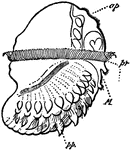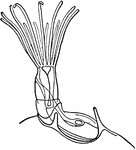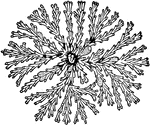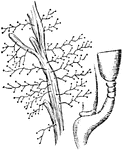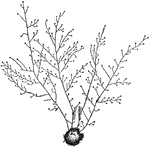
Stage Two in the Fission of Noctiluca Scintillans
An illustration of the second stage of fission in the Noctiluca scintillans. Noctiluca scintillans,…
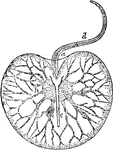
Aboral Side View of the Noctiluca Scintillans
An illustration of the aboral side view of the Noctiluca scintillans. Noctiluca scintillans, also published…

Noctiluca Scintillans
An illustration of the Noctiluca scintillans. Noctiluca scintillans, also published as Noctiluca miliaris,…
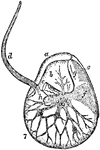
Lateral View of Noctiluca Scintillans
An illustration of the lateral view of the Noctiluca scintillans. Noctiluca scintillans, also published…
Chaetognatha
Chaetognatha is a phylum of predatory marine worms that are a major component of plankton worldwide.…

Nereis
A diagram of of the nephridium of Nereis. Nereis is a genus of polychaete worms in the family Nereidae.…

Dasychone Infracta
An illlustration of a dasychone infracta, a type of annelid. The annelids, collectively called Annelida…
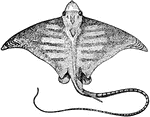
Eagle Ray
The Common Eagle Ray (Myliobatis aquila) is large ray in the Chondrichthyes class of cartilaginous fishes.

Hawaiian Rock Urchin
The Hawaiian Rock Urchin (Echinometra oblongata) is a sea urchin, here "with spines in part removed…
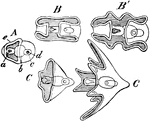
Echinopaedia
Echinopaedia is the name for the early or larval stages of echinoderms like sea stars and sea urchins.…
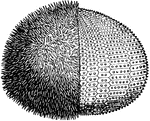
European Edible Sea Urchin
"Sea-urchin (Echinus esculentus). Left side in natural state; right side with spines removed, showing…
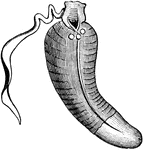
Spoon Worm
Echiurus gaertneri is a species of spoon worm considered annelids, though they are not segmented.

Sea Anemone
Edwardsia beautempsi is a species of sea anemone that lives freely in tubes in the sand, unattached.

Emperor of Japan Angelfish
The Emperor of Japan (Holocanthus imperator) is a species of fish in the Pomacanthidae family of angelfishes.

Bearded Seal
The Bearded Seal (Erignathus barbatus) is a seal in the Phocidae family of true or earless seals.

Noctilucales
An illustration of Noticulales with buds. The Noctilucales are a peculiar order of marine dinoflagellates.…
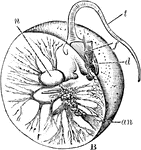
Noctilucales
An illustration of Noticulales in section: an, anus; d, denticle; f, flagellum; t, tentacle. The Noctilucales…

Noctilucales
The Noctilucales are a peculiar order of marine dinoflagellates. They differ from most others in that…
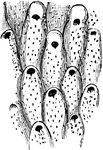
Prehistoric Bryozoan
Eschara elegans (Coscinopleura) is a prehistoric bryozoan, a marine animal similar to a coral.
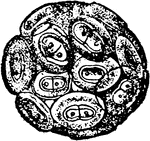
Coccolithophora
A mass of coccoliths; a marine pelagic plant of low order covered with calcereous plates. A coccolithophore…

Prehistoric Bryozoan
Eschara philomela is a prehistoric bryozoan, a marine animal similar to a coral.

Coral
Corals are marine organisms from the class Anthozoa and exist as small sea anemone–like polyps,…
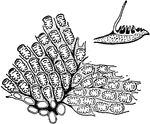
Bryozoan
A modern Bryozoan, a group of cells or zooecia seen from above, and a single cell seen from the side.

Euchone
Euchone elegans is a species of marine worms in the family, Terebellidae, sometimes known as spaghetti…
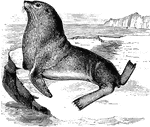
Steller Sea Lion
The Steller Sea Lion (Eumetopias jubatus) is a large pinniped in the Otariidae family of eared seals.…
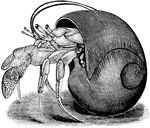
Hermit Crab
This hermit crab (Eupagurus bernhardus) is in the shell of the northern moon snail (Lunatia heros).

Eupsamma
"Eupsamma. A genus of perforate stone-corals, as E. brongniartiana (shown here), of the family Eupsammidae."…
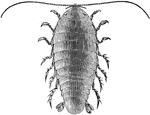
Speckled Sea Louse
The Speckled Sea Louse (Eurydice pulchra) is a parasitic crustacean in the Cirolanidae family.
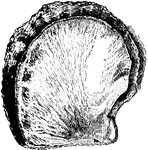
Oyster Shell
An illustration of a oyster shell. The common name oyster is used for a number of different groups of…
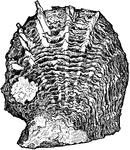
Oyster Shell
An illustration of a oyster shell. The common name oyster is used for a number of different groups of…
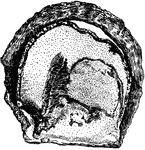
Oyster Shell
An illustration of a oyster shell. The common name oyster is used for a number of different groups of…
Fair-Leader
"Naut.: A strip of board with holes in it for running rigging to pass through and be kept clear, so…

Fairy Shrimp
The Fairy Shrimp (Branchipus diaphanus) is a species of crustacean belonging to the Anostraca order.
Change in Facies
Diagram illustrating change in facies of marine clastics, from sands and muds near the shore to calcareous…
Progressive Overlap of Marine Formations
Section to show normal progressive overlap of marine formations and their shoreward change from limestones…
Offlaps Followed by Overlap
Section to illustrate the relationships of strata formed by a compound, transgressing, retreatal and…
Replacing Overlap
Diagrammatic section to illustrate replacing overlap of shore or continental sands on the right and…
Overlap of Continental Beds
Diagrammatic section to illustrate the overlap of continental beds over a retreatal marine series.

Overlap from the Appalachians to Cincinnati
Restored section from the Appalachians to the Cincinnati region, to show the overlaps of continental…
Progressive Overlap
Sections to illustrate progressive overlap; a) in a continental series, away from the source of supply;…
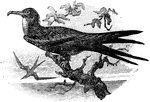
Ascension Frigatebird
The Ascension Frigatebird (Fregata aquila) is a large seabird in the Fregatidae family of frigatebirds.
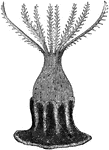
Coral
An illustration of coral. Corals are marine organisms from the class Anthozoa and exist as small sea…

Paradoxides Harlani
Paradoxides was a genus of relatively large trilobites, extinct marine arthropods, that form the class…
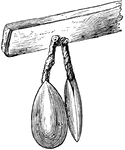
Modern Lingula
Lingula is a genus of brachiopods within the class Lingulata. Lingula is among the few brachiopods surviving…

Dicellocephalus Minnesotenis a Trilobite
Trilobites ("three-lobes") are extinct marine arthropods that form the class Trilobita. Why the trilobites…
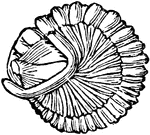
Dicellocephalus Minnesotenis a Trilobite
Trilobites ("three-lobes") are extinct marine arthropods that form the class Trilobita. Why the trilobites…

Dicellocephalus Minnesotenis a Trilobite
Trilobites ("three-lobes") are extinct marine arthropods that form the class Trilobita.The earliest…

Cuttlefish
Cuttlefish are marine animals of the order Sepiida belonging to the Cephalopoda class. Despite their…

Coiled Chambered Shell
Baculites is a genus of extinct marine animals in the Phylum Mollusca and Class Cephalopoda. They are…

